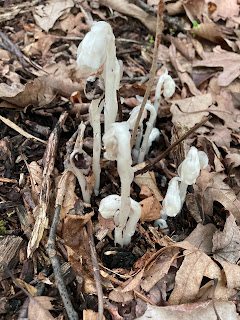They're pale, slightly shimmery, slender, and feed off of the living things around them. You may think I'm referring to vampires, especially those of the modern day pop culture varietal, but in fact I'm referring to Ghost Pipes or Monotropa uniflora L. Ghost Pipes are a parasitic plant native to North America. They grow in damp shaded areas of forests. With a bit of patience and a knack for exploring, Ghost Pipes can be found not far from our own backyards from June to September.
 |
| A trio of Ghost Pipes I found growing in Pennsylvania. |
Ghost Pipes are beautiful and striking, in part because of their entirely white flowers and leaves. In stark contrast to the moss and foliage of the forest floor, Ghost Pipes are white with the occasional fleck of black or blush of pink. The reason plants are thought of as so characteristically green is because of
chlorophyll, the pigment necessary for photosynthesis. Without chlorophyll plants can't effectively capture energy from the sun, making it impossible for them to convert unusable energy to usable energy. This of course raises the question: How on earth do Ghost Pipes survive? The answer is just as fascinating and strange as these little plants - parasitism. The vampire jokes from earlier were not entirely out of context, but instead a reference to Ghost Pipes survival technique. A
parasite is defined as an organism that gains resources from another organism in a way that negatively effects the host. This includes tapeworms, leeches, and head lice. Ghost Pipes are an elegant and unexpected addition to this group. Despite their divergences in aesthetics, Ghost Pipes meet all the scientific criteria of a parasite. Instead of photosynthesizing to produce usable energy Ghost Pipes feed off of the energy of trees through
myccorhizal fungi. Ghost Pipes gain the carbohydrates and nutrients needed to survive by, in essence, hacking the systems trees use to communicate. Myccorhizal fungi use a different type of mutualism to survive, which is called
symbiosis. Instead of hurting their host for their own gain like a parasite does, in a symbiotic relationship both organisms benefit. In this case, myccorhizae grow throughout the root systems of plants assisting in the absorption of phosphorous and nitrogen, compounds necessary to life. In return, myccorhizae receive carbohydrates. This symbiotic relationship provides a net gain for both parties.
Studies have recently uncovered that myccrohizae don't just help individual plants, but instead interconnect groups. Myccorhizal system are predominantly underground, often stretching larger than the root system of any one plant. This allows plants to
pass signals and resources to other plants through myccorhizae.
 |
| Ghost Pipes in leaf litter |
Entering into this fascinating interconnecting web is the
Ghost Pipe. Instead of taking resources directly from the tree, the Ghost Pipe connects to the myccorhizal system. Ghost Pipes fool the fungi by acting as if they are forming a myccorhizal relationship. Once they're in the system they can gain sugar and nutrients the tree produces through the myccorhizae.
Ghost Pipes are not alone in this habit, in fact, many different plants are parasites of myccorhizae. Although we traditionally view parasites with disdain, the presents of Ghost Pipes, and their relatives the
snow plant, the
broomrape family,
pinesap, and
American cancer root are indicators of a healthy forest and a healthy miccorhizal system.
Should you ever come across one of these botanical draculas, be sure to keep looking because you're bound to find some fantastic fungal evidence of the myccorhizal systems they feed on, or at the very least some more Ghost Pipes!
 |
Cancer root I found in the leaf litter of a local trail.
|



No comments:
Post a Comment